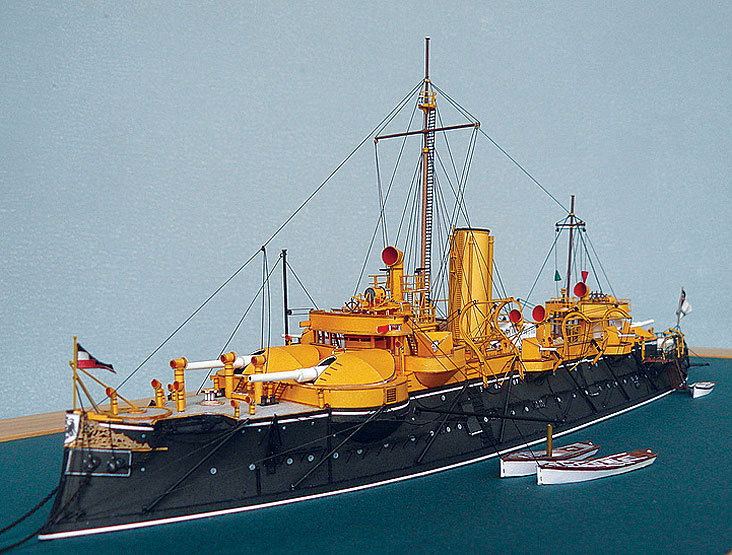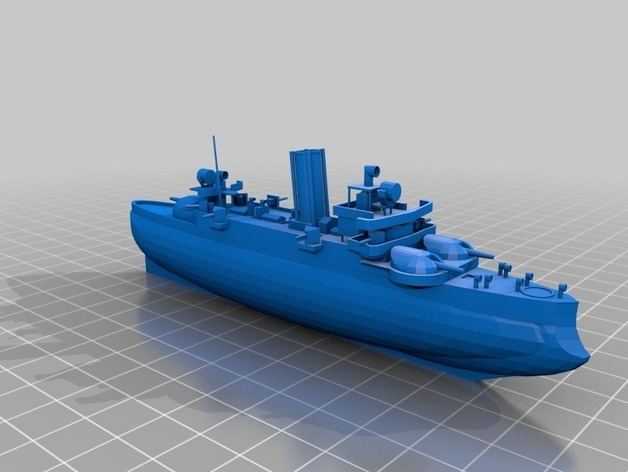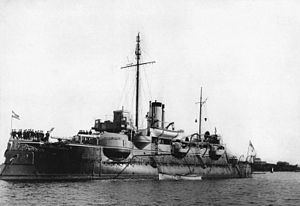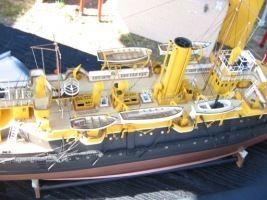Laid down January 1890 Displacement 3.5 million kg Launched 8 November 1890 Weight 3,500 tons | Commissioned 1 April 1892 Construction started January 1890 Length 79 m | |
 | ||
Fate Scrapped at Danzig, 1921 Class and type Siegfried-class coast defense ship | ||
SMS Beowulf was the second vessel of the six-member Siegfried class of coastal defense ships (Küstenpanzerschiffe) built for the German Imperial Navy. Her sister ships were Siegfried, Frithjof, Heimdall, Hildebrand, and Hagen. Beowulf was built by the AG Weser shipyard between 1890 and 1892, and was armed with a main battery of three 24-centimeter (9.4 in) guns. She served in the German fleet throughout the 1890s and was rebuilt in 1900 - 1902. She served in the VI Battle Squadron after the outbreak of World War I in August 1914, but saw no action. Beowulf was demobilized in 1915 and used as a target ship for U-boats thereafter. She was ultimately broken up for scrap in 1921.
Contents

Design

Beowulf was 79 meters (259 ft) long overall and had a beam of 14.90 m (48.9 ft) and a maximum draft of 5.74 m (18.8 ft). She displaced 3,741 long tons (3,801 t) at full combat load. Her propulsion system consisted of two vertical 3-cylinder triple expansion engines. Steam for the engines was provided by four coal-fired boilers. The ship's propulsion system provided a top speed of 15.1 kn (28.0 km/h; 17.4 mph) and a range of approximately 1,490 nautical miles (2,760 km; 1,710 mi) at 10 kn (19 km/h; 12 mph). Beowulf had a crew of 20 officers and 256 enlisted men.

The ship was armed with three 24 cm K L/35 guns mounted in three single gun turrets. Two were placed side by side forward, and the third was located aft of the main superstructure. They were supplied with a total of 204 rounds of ammunition. The ship was also equipped with eight 8.8 cm SK L/30 guns in single mounts. Beowulf also carried four 35 cm (14 in) torpedo tubes, all in swivel mounts on the deck. One was at the bow, another at the stern, and two amidships. The ship was protected by an armored belt that was 240 mm (9.4 in) amidships, and an armored deck that was 30 mm (1.2 in) thick. The conning tower had 80 mm (3.1 in) thick sides.
Service history

Beowulf was laid down in 1890 at the AG Weser shipyard in Bremen. She was launched on 8 November 1890, and completed on 1 April 1892. Among the crew that commissioned the ship was the officer Franz von Hipper, who would go on to command the German battle fleet during World War I. Directly after her commissioning, she joined the I Division of the fleet for its annual training exercises, along with the three ironclads Baden, Bayern, and Württemberg. Beowulf remained on active service through the winter of 1892 - 1893, when she and her sister ship Siegfried joined the elderly ironclads König Wilhelm and Deutschland for a winter training cruise in the Mediterranean Sea.

In 1893, Beowulf again participated in the annual fleet maneuvers, this time alongside her recently-commissioned sister Frithjof and several old ironclads. On the first set of maneuvers, Beowulf and the other capital ships performed as the hostile French fleet, which was "attacked" by torpedo boats in the North Sea. The second set of maneuvers took place in the Baltic Sea, and Beowulf and the ironclads again simulated a French fleet. In 1897, Beowulf again participated in the annual summer maneuvers in the III Division, along with Siegfried and Hildebrand. Her other three sisters were assigned to the IV Division. Following her service in the 1899 summer maneuvers, Beowulf was placed in reserve, as the flagship of the reserve squadron in the North Sea.
Beowulf served on active duty with the fleet until 1900, when she was taken into drydock at the Kaiserliche Werft shipyard in Danzig for an extensive reconstruction. The ship was lengthened to 86.13 m (282.6 ft), which increased displacement to 4,320 t (4,250 long tons; 4,760 short tons). Her old boilers were replaced with eight new Marine type boilers, and a second funnel was added. Her secondary battery was increased to ten 8.8 cm guns, and the 35 cm torpedo tubes were replaced with three 45 cm (18 in) tubes. Work was completed by 1902. She then returned to service with the fleet, and in 1903, was assigned to the II Division, along with three of her sister ships.
She remained in the fleet until the outbreak of World War I in August 1914, when she was mobilized into the VI Battle Squadron for coastal defense, along with her sister ships. In May 1915, Beowulf participated in a combined naval and ground assault on the port of Libau in the Baltic. The attack took place on 7 May, and consisted of Beowulf, the armored cruisers Prinz Adalbert, Roon, and Prinz Heinrich, and the light cruisers Augsburg, Thetis, and Lübeck. They were escorted by a number of destroyers, torpedo boats, and minesweepers. The IV Scouting Group of the High Seas Fleet was detached from the North Sea to provide cover for the operation. The bombardment went as planned, though the destroyer V107 struck a mine in Libau's harbor, which blew off her bow and destroyed the ship. German ground forces were successful in their assault however, and took the city. On 31 August 1915, the VI Battle Squadron was demobilized, and Beowulf's crew was transferred to other warships. She was then used as a target ship for U-boats. Starting in 1918, she was used as an icebreaker in the Baltic Sea. On 17 June 1919, she was stricken from the naval register. She was sold to Norddeutscher Tiefbaugesellschaft in Berlin. Beowulf was broken up for scrap in 1921 in Danzig.
